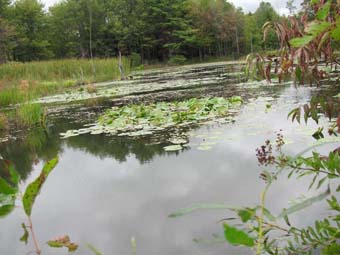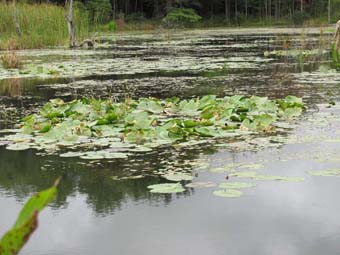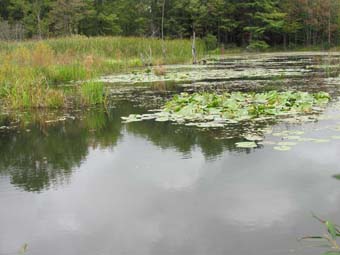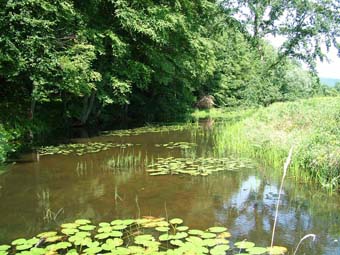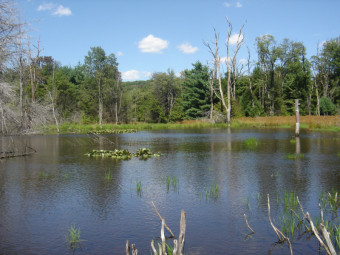Spatterdock – Water-lily Emergent Wetland
System: Palustrine
Subsystem: Non-persistent
PA Ecological Group(s): Emergent Wetland and Marsh Wetland
Global Rank:GNR
![]() rank interpretation
rank interpretation
State Rank: S4
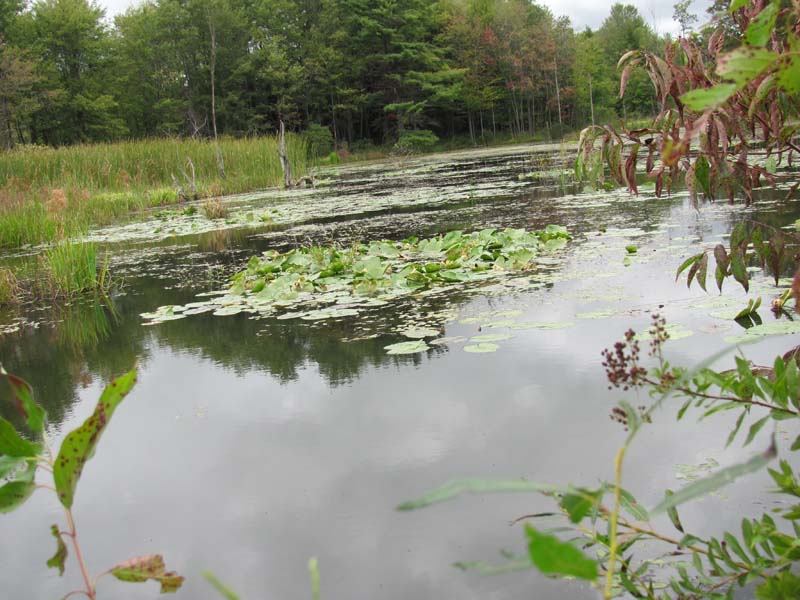
General Description
A combination of emergent and floating-leaved, rooted hydromorphic vegetation dominates this community type. This type occurs in lakes, ponds, and slow-moving streams. The substrate is usually mineral soil overlain by loose sediments that vary from mineral to organic. Water levels may fluctuate seasonally, but the substrate is seldom dry. The most typical species are spatterdock (Nuphar advena/ N. variegata) and fragrant water-lily (Nymphaea odorata). Other species include water smartweed (Persicaria amphibia), bur-reed (Sparganium spp), wapato (Sagittaria latifolia), broad-leaved water-plantain (Alisma subcordatum), soft-stem bulrush (Schoenoplectus tabernaemontani), and arrow-arum (Peltandra virginica). There is usually an admixture of submerged and free-floating aquatic species such as pondweeds (Potamogeton spp.), water-milfoils (Myriophyllum spp.), coontail (Ceratophyllum demersum), and duckweeds (Lemna spp.).
Rank Justification
Uncommon but not rare; some cause for long-term concern due to declines or other factors.
Identification
- Rooted aquatic or open marsh community occupies shallow-water depressions, oxbow ponds, backwater sloughs of river floodplains, slow-moving streams, ponds, and borders of lakes
- Dominated by rooted, floating-leaved aquatic species, with both submergent and emergent aquatics
- Spatterdock (Nuphar advena and N. variegata (split)) and fragrant water-lily (Nymphaea odorata) are dominants, either in combination together, or singly
Herbs
* limited to sites with higher soil calcium
Vascular plant nomenclature follows Rhoads and Block (2007). Bryophyte nomenclature follows Crum and Anderson (1981).
International Vegetation Classification Associations:
USNVC Crosswalk:None
Representative Community Types:
Water-lily Aquatic Wetland (CEGL002386)
NatureServe Ecological Systems:
Great Lakes Coastal Wetlands Complex (CECX005702)
Laurentian-Acadian Freshwater Marsh (CES201.594)
Northern Great Lakes Coastal Marsh (CES201.722)
Central Interior Highlands and Appalachian Sinkhole and Depression Pond (CES202.018)
NatureServe Group Level:
None
Origin of Concept
Fike, J. 1999. Terrestrial and palustrine plant communities of Pennsylvania. Pennsylvania Natural Diversity Inventory. Pennsylvania Department of Conservation and Recreation, Bureau of Forestry, Harrisburg, PA. 86 pp.
Pennsylvania Community Code*
HY : Spatterdock – Water Lily Wetland
*(DCNR 1999, Stone 2006)
Similar Ecological Communities
Spatterdock – Water-lily Emergent Wetland may occur intermingled with or surrounded by the Pickerel-weed – Arrow-arum – Arrowhead Emergent Wetland. These two types may intergrade but the Spatterdock – Water-lily Emergent Wetland represents the rooted aquatic vegetation dominated by spatterdock (Nuphar advena/ N. variegata) and fragrant water-lily (Nymphaea odorata).
Fike Crosswalk
Spatterdock - water lily wetland
Conservation Value
Spatterdock – Water-lily Wetland may serve as important habitat cover for amphibian, reptile, fish, and shore and marsh bird species.
Threats
Alteration to the hydrological regime is a major threat to this community (e.g., draining, impoundments, beaver dams) and can lead to habitat destruction and/or shifts in community function and dynamics. Clearing and development of adjacent land can lead to an accumulation of agricultural run-off and pollution, sedimentation, and insolation/thermal pollution.
Management
A natural buffer around the wetland should be maintained in order to minimize nutrient runoff, pollution, and sedimentation. The potential for soil erosion based on soil texture, condition of the adjacent vegetation (mature forests vs. clearcuts), and the topography of the surrounding area (i.e., degree of slope) should be considered when establishing buffers. The buffer size should be increased if soils are erodible, adjacent vegetation has been logged, and the topography is steep as such factors could contribute to increased sedimentation and nutrient pollution. Direct impacts and habitat alteration should be avoided (e.g., roads, trails, filling of wetlands) and low impact alternatives (e.g., elevated footpaths, boardwalks, bridges) should be utilized in situations where accessing the wetland can not be avoided. Care should also be taken to control and prevent the spread of invasive species within the wetland.
Trends
These wetlands were probably more common but declined due to wetland draining/filling. Wetland protection has most likely stabilized the decline of these communities.
Range Map
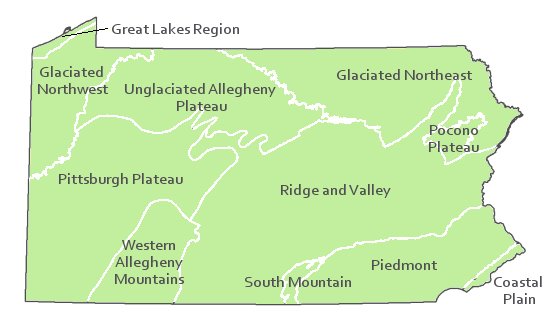
Pennsylvania Range
Statewide
Global Distribution
Alabama, Arkansas, Connecticut, Delaware, Florida, Georgia, Iowa, Illinois, Indiana, Kentucky, Louisiana, Maryland, Maine, Massachusetts, Michigan, Minnesota, Mississippi, Missouri, New Hampshire, North Carolina, New Jersey, New York, Oklahoma, Ohio, Pennsylvania, Rhode Island, South Carolina, Tennessee, Texas, Vermont, Virginia, Wisconsin, West Virginia, and Ontario, Canada.
Ambrose, J. 1990a. Georgia's natural communities--A preliminary list. Unpublished document. Georgia Natural Heritage Inventory. 5 pp.
Anderson, D. M. 1982. Plant communities of Ohio: A preliminary classification and description. Division of Natural Areas and Preserves, Ohio Department of Natural Resources, Columbus, OH. 182 pp.
Breden, T. F., Y. R. Alger, K. S. Walz, and A. G. Windisch. 2001. Classification of vegetation communities of New Jersey: Second iteration. Association for Biodiversity Information and New Jersey Natural Heritage Program, Office of Natural Lands Management, Division of Parks and Forestry, New Jersey Department of Environmental Protection, Trenton.
Clancy, K. 1996. Natural communities of Delaware. Unpublished review draft. Delaware Natural Heritage Program, Division of Fish and Wildlife, Delaware Division of Natural Resources and Environmental Control, Smyrna, DE. 52 pp.
Fike, J. 1999. Terrestrial and palustrine plant communities of Pennsylvania. Pennsylvania Natural Diversity Inventory. Pennsylvania Department of Conservation and Recreation. Bureau of Forestry. Harrisburg, PA. 86 pp.
Fleming, G. P., P. P. Coulling, D. P. Walton, K. M. McCoy, and M. R. Parrish. 2001. The natural communities of Virginia: Classification of ecological community groups. First approximation. Natural Heritage Technical Report 01-1. Virginia Department of Conservation and Recreation, Division of Natural Heritage, Richmond, VA. Unpublished report. January 2001. 76 pp.
FNAI [Florida Natural Areas Inventory]. 1990. Guide to the natural communities of Florida. Florida Natural Areas Inventory and Florida Department of Natural Resources, Tallahassee. 111 pp.
Foti, T., M. Blaney, X. Li, and K. G. Smith. 1994. A classification system for the natural vegetation of Arkansas. Proceedings of the Arkansas Academy of Science 48:50-53.
Gawler, S. C. 2002. Natural landscapes of Maine: A guide to vegetated natural communities and ecosystems. Maine Natural Areas Program, Department of Conservation, Augusta, ME. [in press]
Harrison, J. W., compiler. 2004. Classification of vegetation communities of Maryland: First iteration. A subset of the International Classification of Ecological Communities: Terrestrial Vegetation of the United States, NatureServe. Maryland Natural Heritage Program, Maryland Department of Natural Resources, Annapolis. 243 pp.
Hoagland, B. 2000. The vegetation of Oklahoma: A classification for landscape mapping and conservation planning. The Southwestern Naturalist 45(4):385-420.
Horvath, Jamie L., Timothy A. Block, and Ann F. Rhoads. 2008. Description of the population, canopy cover, and associated vegetation of the globally rare sedge Carex polymorpha (Cyperaceae) in Nescopeck State Park, Pennsylvania. In Sedges: Uses, Diversity, and Systematics of the Cyperaceae, eds. R. Naczi and B. Ford. Missouri Botanical Garden Press, St. Louis, MO.
INAI [Iowa Natural Areas Inventory]. No date. Vegetation classification of Iowa. Iowa Natural Areas Inventory, Iowa Department of Natural Resources, Des Moines.
Midwestern Ecology Working Group of NatureServe. No date. International Ecological Classification Standard: International Vegetation Classification. Terrestrial Vegetation. NatureServe, Minneapolis, MN.
NAP [Northern Appalachian-Boreal Forest Working Group]. 1998. Northern Appalachian-Boreal Working group discussions. The Nature Conservancy, Boston, MA.
NatureServe 2010. NatureServe Explorer: An online encyclopedia of life Version 7.1. NatureServe, Arlington, VA. Available http://www.natureserv.org/explorer (accessed: 23 November 2011).
NatureServe Ecology - Southeastern United States. No date. Unpublished data. NatureServe, Durham, NC.
Peet, R. K., T. R. Wentworth, M. P. Schafale, and A.S. Weakley. 2002. Unpublished data of the North Carolina Vegetation Survey. University of North Carolina, Chapel Hill.
Penfound, W. T. 1953. Plant communities of Oklahoma lakes. Ecology 34:561-583.
Pennsylvania Department of Conservation and Natural Resources (DCNR). 1999. Inventory Manual of Procedure. For the Fourth State Forest Management Plan. Pennsylvania Bureau of Forestry, Division of Forest Advisory Service. Harrisburg, PA. 51 ppg.
Rawinski, T. 1984. Natural community description abstract - southern New England calcareous seepage swamp. Unpublished report. The Nature Conservancy, Boston, MA. 6 pp.
Rhoads, Ann F. and Timothy A. Block. 2002. Nescopeck State Park; Inventory of PNDI-listed Plants and Plant Communities. Report submitted to DCNR, Bureau of State Parks.
Rhoads, Ann F. and Timothy A. Block. 2004. East Goshen Township Wetlands; Vegetation Inventory and Management Recommendations. Reoprt submitted to East Goshen Township, Chester County, PA.
Schafale, M. P., and A. S. Weakley. 1990. Classification of the natural communities of North Carolina. Third approximation. North Carolina Department of Environment, Health, and Natural Resources, Division of Parks and Recreation, Natural Heritage Program, Raleigh. 325 pp.
Schmalzer, P. A., and H. R. DeSelm. 1982. Vegetation, endangered and threatened plants, critical plant habitats and vascular flora of the Obed Wild and Scenic River. Unpublished report. USDI National Park Service, Obed Wild and Scenic River. 2 volumes. 369 pp.
Schotz, Al. Personal communication. Community Ecologist. Alabama Natural Heritage Program. Huntingdon College, Massey Hall, 1500 East Fairview Avenue, Montgomery, AL 36106-2148.
Sperduto, D. D., and W. F. Nichols. 2004. Natural communities of New Hampshire: A guide and classification. New Hampshire Natural Heritage Inventory, DRED Division of Forests and Lands, Concord. 242 pp.
Stone, B., D. Gustafson, and B. Jones. 2006 (revised). Manual of Procedure for State Game Land Cover Typing. Commonwealth of Pennsylvania Game Commission, Bureau of Wildlife Habitat Management, Forest Inventory and Analysis Section, Forestry Division. Harrisburg, PA. 79 ppg.
Swain, P. C., and J. B. Kearsley. 2001. Classification of natural communities of Massachusetts. September 2001 draft. Natural Heritage and Endangered Species Program, Massachusetts Division of Fisheries and Wildlife. Westborough, MA.
TDNH [Tennessee Division of Natural Heritage] Unpublished data. Tennessee Division of Natural Heritage, 14th Floor, L&C Tower, 401 Church Street, Nashville, TN 37243-0447. 615-532-0431
Thompson, E., and J. Jenkins. 1992. Summary of field data from Minuteman National Park plant communities study. A report prepared under a contract with the Massachusetts Natural Heritage and Endangered Species Program for the National Park Service. 39 pp.
WNHIP [Wisconsin Natural Heritage Inventory Program]. No date. Vegetation classification of Wisconsin and published data. Wisconsin Natural Heritage Program, Wisconsin Department of Natural Resources, Madison.
Zanoni, T. A., P. G. Risser, and I. H. Butler. 1979. Natural areas for Oklahoma. Oklahoma Natural Heritage Program, Norman. 72 pp.
Cite as:
Eichelberger, B. 2022. Pennsylvania Natural Heritage Program. Spatterdock – Water-lily Emergent Wetland Factsheet. Available from: https://www.naturalheritage.state.pa.us/community.aspx?=15996 Date Accessed: December 13, 2025

